The first session of the workshop set the stage by discussing the history of the electric grid, the current and future sources of electricity generation, distribution and generation challenges, and key technologies that could help transition the current legacy grid into a grid structured to meet these future challenges.
Robert J. Thomas (Cornell University; chair of the workshop planning group), John Guckenheimer (Cornell University; study committee co-chair), and Thomas J. Overbye (University of Illinois, Urbana-Champaign; study committee co-chair) opened the workshop and introduced the speaker for the first session, former Department of Energy (DOE) Secretary Steven Chu (Stanford University).
LOW-COST PATHWAYS TO GRID INTEGRATION OF RENEWABLE ENERGY: SKATING TO WHERE THE PUCK IS GOING TO BE
Steven Chu, Stanford University
Steven Chu described how the energy landscape has changed rapidly over recent decades and outlined the importance of future improvements for the grid infrastructure and capabilities in the decades to come. He discussed some grid and consumer technologies that have the potential to improve the efficiency, reliability, and security of the electricity supply while also lessening emissions of greenhouse gases and improving human health.
Chu noted that until recently, petroleum production in the United States had been declining since about 1970. However, he said the introduction of hydraulic
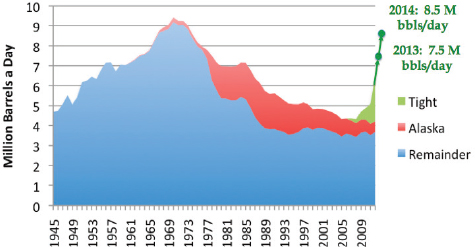
FIGURE 2.1 U.S. oil production since 1945. SOURCE: Steven Chu, Stanford University, presentation to the workshop; from Gail E. Tverberg, “Twelve Reasons Why Globalization is a Huge Problem,” February 22, 2013, http://ourfiniteworld.com, based on Energy Information Administration data.
fracturing around 2005 led to a sudden increase in oil production that amounted to an additional 4.5 million barrels per day by 2014 (totaling approximately 8.5 million barrels per day overall), as shown in Figure 2.1. This production increase is more than the current oil production of all countries except Saudi Arabia, the United States, and Russia.
The U.S. Energy Information Administration (EIA), Chu noted, estimated that the rest of the world may have up to 10 times more tight oil1 and shale gas than the United States. However, he warned there are great uncertainties in this estimate, and in fact, the amount of shale gas that is accessible globally may be only 30 to 40 percent of what is available in the United States. Figure 2.2 shows the EIA estimates for where, and how much, technically recoverable shale gas may be accessible.
Chu also discussed the environmental and human health implications of increased particulate matter, specifically a potential increased risk of lung cancer (Raaschou-Nielsen et al., 2013). He commented that the understanding of the risks of climate change is analogous to the understanding of smoking; notably, there was a delay in understanding the harms of smoking just as there was a delay in understanding the impacts of CO2 on climate change. The damage to the environment from past CO2 emissions will not be known for 50 to 100 years. Since CO2 will remain for 300 to 3,000 years, Chu stated that a prudent risk management strategy calls for decreasing carbon emissions.
____________________
1 Tight oil is defined as light crude oil within rock formations in low-permeable reservoirs.
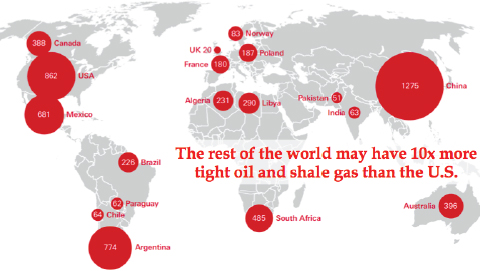
FIGURE 2.2 Estimates of global technically recoverable shale gas. SOURCE: Steven Chu, Stanford University, presentation to the workshop; from the Energy Information Administration, “Technically Recoverable Shale Oil and Shale Gas Resources: An Assessment of 137 Shale Formations in 41 Countries Outside the United States,” June 13, 2013, http://www.eia.gov/analysis/studies/worldshalegas/.
What Are the Issues Facing Our Electric Grid?
Aged Transmission and Distribution Infrastructure
Chu commented that the United States has an aged transmission and distribution infrastructure architecture based on centralized, local generation. Ongoing challenges facing the grid include congestion, severe weather or other natural phenomena, and market and regulatory complexities. He noted that there are also new challenges, including intermittent renewables, cybersecurity, physical sabotage, and dynamic management of distributed generation.
The Northeast blackout of 2003 that cut off power to eight states in the United States and part of Canada, according to Chu, ultimately cost an estimated loss of $6 billion to $10 billion. He ascribed the blackout as being rooted in an out-of-date grid infrastructure. An electrical line disruption in northern Ohio resulted in a phase lag and led to one of the most massive blackouts in modern history. Chu said that faster real-time sensing and better grid control systems may have helped to prevent the resulting blackout.
The number of outages affecting more than 50,000 customers is also increasing, Chu said, reaching 349 during 2005 to 2009, up from 92 in 2001 to 2005, and 58 in 1996 to 2000 (NERC, 2009; EIA, 2009). He stated that many of these out-
ages are a result of delayed maintenance and much of the infrastructure is past its designed life span.
Chu noted that DOE was given $34 billion in addition to its normal budget of $26 billion as part of the American Recovery and Reinvestment Act. Part of this money was spent deploying phasor measurement units (or synchrophasors) to provide fine-grained sensing of the state of the grid. He explained that these modern instruments can quickly spot oscillations in the grid and use systems that can provide reactive support, such as flexible alternating current transmission system (FACTS) devices. Oscillations were previously isolated using circuit breakers, but this approach can create strains in other lines as the amount of excess capacity in the grid has been squeezed.
Phasor measurement units measure the magnitude and the phase angle of the electric power signal time synchronized with GPS every 10 to 30 milliseconds, resulting in petabyte-scale data being generated. Chu noted that DOE began giving out these units in 2009, but as of 2012 utility companies were still not sharing the phasor measurement data with each other. A workshop participant noted that sharing has improved since that time, though.
Intermittent Renewable Energy
Chu stated that intermittent renewable energy, particularly wind and solar energy, will provide an increasing fraction of electricity generation in the future. This is good for the environment and difficult for the electric grid.
Wind turbines are increasing in reliability, efficiency, and size, and their prices are decreasing due to manufacturing economies of scale, according to Chu. Wind energy costs have plummeted dramatically since 1980, and the deployment of installed capacity has dramatically increased over the past decade, as shown in Figure 2.3. Chu noted that signed power purchase agreements (PPAs) for wind energy are a good indicator of where the industry is going. These PPA contracts define the commercial terms for the sale of electricity between two parties, including when a project will begin commercial operation, the schedule for delivery of electricity, the payment terms, and termination. He explained that the price agreed upon in a PPA is an indication of the market value for a type of electricity in a specific location and time. PPA prices tend to be highest in western states, such as California, and lowest in interior states, such as North and South Dakota, Iowa, and Kansas. However, he noted that PPA wind prices have been decreasing nationwide since 2009, as illustrated in Figure 2.4. Currently, the United States subsidizes wind energy through a wind production tax credit. However, Chu noted, owing to the current low prices in some geographic regions, the tax credit may not be essential nationwide. He suggested that determining whether or how to phase out the tax credit will be important to the future of the industry. Chu noted that the United
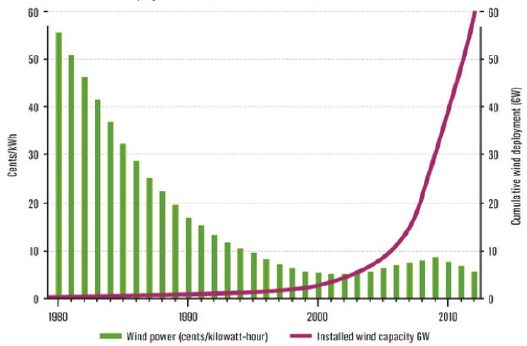
FIGURE 2.3 Wind energy costs and installed capacity from 1980 to 2012. SOURCE: Steven Chu, Stanford University, presentation to the workshop; from Department of Energy, “Revolution Now: The Future Arrives for Four Clean Energy Technologies,” Washington, D.C., September 17, 2013, updated version available at http://energy.gov/eere/downloads/revolution-now-future-arrives-four-clean-energytechnologies-2014-update.
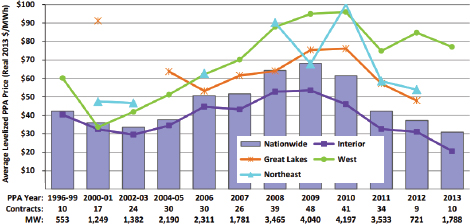
FIGURE 2.4 Time trends for wind power purchase agreements by geographic location from 1996 to 2013, adjusted for inflation and shown in 2013 dollars. SOURCE: Steven Chu, Stanford University, presentation to the workshop; from Wiser et al. (2014).
States is still lagging some other countries in wind electricity as a percentage of overall electricity consumption, even though the United States has extensive land resources. (The availability of land is key because offshore wind energy production is about three times more expensive than production on land.)
Chu said that solar energy is also becoming increasingly more viable as the cost of photovoltaic (PV) modules continues to decrease. Over the past 40 years, the price for PV modules has declined 40-fold. He noted that this rapid price drop, however, has led to some difficulties for some PV suppliers such as Solyndra and Suntech Power. Currently, utility-scale solar energy in Texas is comparable to the cost of new natural gas. Chu commented that the United States currently provides an investment tax credit of 30 percent, but he believes this could start ramping down to 10 percent in the next 6 to 10 years without disturbing the market. Solar electricity generation in the United States has skyrocketed since 2009, as shown in Figure 2.5. Chu said that DOE’s loan program for solar and wind farms is paying off, and, even taking into account riskier loans (such as those to Solyndra and Fisker, which incurred losses), the United States is still estimated to net a $5 billion profit on its loan investments. However, in spite of this growth in solar energy capacity, he noted that this source still accounted for only 0.25 percent of all electricity generated in the United States in 2013. There is also great potential for solar power in developing countries, Chu noted, where solar modules and batteries can
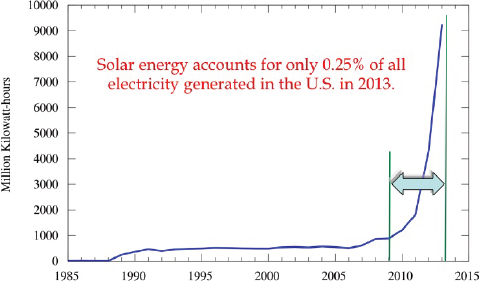
FIGURE 2.5 U.S. solar electricity generation from 1985 to 2013. SOURCE: Steven Chu, Stanford University, presentation to the workshop.
operate at a wide range of temperatures and provide inexpensive electricity for uses such as LED lighting, cell phones, refrigeration, and water purification.
Chu suggested that the renewable energy sector is about to change dramatically. He compared the natural gas, solar, and wind capacity additions in the first half of 2013 and 2014, which show increased investment in solar and wind, a high investment in natural gas, and no investment in coal. These investment amounts are shown in Figure 2.6.
Chu cautioned that the current electric grid, however, may have problems integrating these new renewable energy sources. The grid is made up of three major components (Figure 2.7): the Western Interconnection, the Eastern Interconnection, and the Texas Interconnection. Chu stated that the generation of electricity is not optimally distributed for the current grid; this is especially true for solar and wind energy. Because renewable energy is intermittent and can fade quickly, such as when the weather is cloudy or the wind stops blowing, the grid needs to be able to compensate when needed. Figure 2.8 shows the U.S. electricity generation sources and existing transmission lines, as well as new proposed transmission lines for solar and wind power.
While the U.S. grid is not designed to transport electricity long distances, Chu noted that high-power/high-voltage transistors can revolutionize high-voltage direct-current transmission lines and FACTS devices. Current long-range transmission is being addressed between European countries with the European high-voltage transmission grid and between provinces in China with China’s national grid plans for 2020. Chu said that if the United States was to move to more high-voltage transmission, it could mean losing significantly fewer electrons per

FIGURE 2.6 Natural gas, solar, and wind lead power plant capacity additions in the first half of 2014. SOURCE: Steven Chu, Stanford University, presentation to the workshop; from EIA (2014).
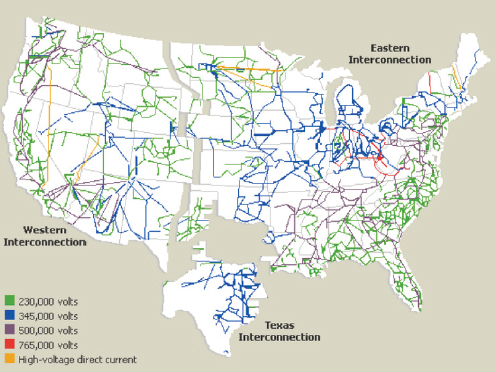
FIGURE 2.7 U.S. electric grid system. SOURCE: Steven Chu, Stanford University, presentation to the workshop; from Judith Curry, “Transmission planning: Wind and solar,” Climate Etc., May 7, 2015, http://judithcurry.com/2015/05/07/transmission-planning-wind-and-solar/.
kilometer traveled. There are current proposals for new 765-kilovolt long-distance transmission lines, Chu stated, but this proposal has been around for many years without much action or funding.
Cost of Distributed Generation
Chu stated that in some cases the cost of rooftop home solar generation is competitive with utility prices. Third-party solar installation—where a company creates a PPA with a household to install and maintain the company’s solar panels and sell the generated solar power for a fixed number of years, often at no up-front cost to the household—can result in the consumer receiving electricity at a kilowatt-hour price that is lower than what is available through a utility company. Chu expects that consumers will increasingly participate in these third-party solar installations, which will result in a decreased need for energy during peak solar production times (usually noon to 4 p.m.) and an increased need for more electricity as the solar power fades in the evening.
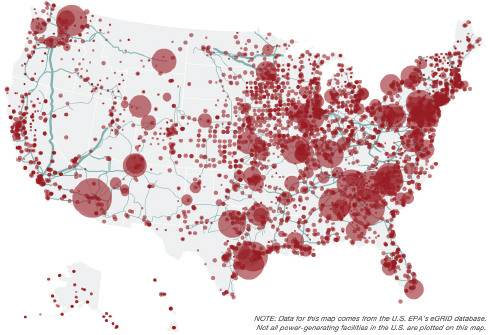
FIGURE 2.8 U.S. electricity generation sources and existing transmission lines (top); U.S. solar power capacity and proposed transmission lines (top of next page); and proposed wind transmission lines (bottom of next page). SOURCE: Steven Chu, Stanford University, presentation to the workshop; from National Public Radio, “Visualizing the U.S. Electric Grid,” April 24, 2009, http://www.npr.org/2009/04/24/110997398/visualizing-the-u-s-electric-grid. Source: American Electric Power, American Wind Energy Association, Center for American Progress, Department of Energy, Edison Electric Institute, Energy Information Administration, Electric Power Research Institute, Federal Energy Regulatory Commission, National Renewable Energy Laboratory, U.S. Environmental Protection Agency, Western Resource Advocates. Credit: Producer: Andrew Prince; Designer: Alyson Hurt; Editors: Avie Schneider and Vikki Valentine; Supervising Editors: Anne Gudenkauf and Quinn O’Toole; Additional Research: Jenny Gold; Database and GIS Analysis: Robert Benincasa.

Many municipal and institutional organizations have become their own power stations as well, Chu noted. For example, the Texas Medical Center has a combined heat and power system capable of producing 48 megawatts of on-site generation, with 32,000 tons of chilled water capacity and an 8.8-million-gallon thermal energy storage tank. Stanford University is currently building a similar power plant.
Electric Vehicles and Consumer Energy Storage
Electric vehicles and consumer energy storage add further complications to the grid, Chu said, and may become a problem once electric vehicles are widely used. He believes that current electric vehicle deployment is slow in part because battery prices, while dropping, continue to remain high. He noted that there has been significant progress in battery research and development, although it does take 4 to 5 years to develop new automotive batteries, in large part because of extensive safety testing; he believes that innovative battery chemistries will likely be widespread in the near future.
New Business Models and Regulations Are Needed
As technology changes the paradigm of the grid, Chu said, new business models and regulations are needed. He explained that utility companies are becoming distributors that aggregate power mostly through day-ahead bidding—with approximately 90 to 95 percent of electricity being purchased this way—with fewer long-term contracts. Utilities aggregate from natural gas, coal, nuclear, solar, and wind, but typically only nuclear power will have a long-term contract in place. In many geographic areas, the independent system operator (ISO) processes the bids and feeds the information to the utility company. In addition to the long-term contracts and the day-ahead market, Chu explained, there are mechanisms to fill gaps in electricity needs and provide stability across minutes, seconds, and sub-seconds throughout the grid. However, he noted, the day-ahead market for renewable energy is challenging because it is difficult to predict generation in advance. He said that deeper penetration of renewable sources may require adjustments by energy regulators, utility companies, and ISOs. In particular, Chu emphasized, more 1-hour and 15-minute bidding may allow renewables to compete more effectively.
Other changes in sensors, load prediction (via machine learning) and control, and better forecasting and dynamic demand response could help modernize the grid, in Chu’s estimation. Forecasting of renewable energy is improving. Utility companies often aggregate power generation from merchant providers of energy, and, Chu said, they also should be able to aggregate consumers who would sign up to allow the utility company to modify their thermostats, electric hot water heater, and other high-energy-use devices. He said that various predictive models
have been developed for distribution load forecasting, including stochastic time-series models.2
The current paradigm was described briefly by Chu as follows. The ISOs balance the electricity supply and demand using day-ahead, hour-ahead, and 15-minute-ahead pricing and then schedule the needed electricity to the utility company. The utility company distributes the electricity to consumers on a predefined price structure, such as the Tiers 1-4 in California, that have an increasing kilowatt-hour price. Typically, the wholesale price of electricity is less than half of what utility companies charge consumers per kilowatt-hour. This system allows for utility companies to pay for transmission and distribution, to earn a profit, and to create a stable system.
However, Chu said, this system is changing. As noted above, a customer’s own solar panels might provide electricity at a kilowatt-hour price below what the utility company can charge. The home could then return or sell its unused electricity to the grid, although the details of this exchange need to be established. As electric vehicles become more commonplace over the next decade and prices for stationary batteries with larger capacities decrease, Chu observed that consumers may opt to use solar power to charge their own stationary battery and power their electric vehicle. He said that consumers may also utilize a gas utility to power a personal electricity generator, the waste heat of which can provide hot water. This scenario will result in generation from many sources (centralized baseload such as coal and gas and intermittent renewables such as solar and wind), with centralized storage and distributed intermittent generation, local storage, and load all being connected by a legacy grid that was not designed to handle such a complex system. Both the current and the shifting paradigms are shown in Figure 2.9.
Solar and battery technology for both vehicles and stationary storage could be disruptive to electricity generation and distribution, according to Chu, but utility companies are not focused on transitioning to the low-cost option of utilizing these technologies. The main reason, he suspects, is that utilities are monopolies and may not have proper incentives to innovate and adopt new technologies. Chu recommended that utility companies work with regulators to upgrade infrastructure to better integrate renewable energy. For example, he proposed the following solution to align utility company incentives with deployment of solar energy: offer consumers rooftop electricity and in-home energy storage where distribution companies partner with third-party installers so that distributed generation and storage is owned, installed, and maintained by energy providers.
____________________
2 Some of these stochastic time-series models include the autoregressive model, autoregressive moving average model, autoregressive integrated moving average model, and other models using fuzzy logic and neural networks.

FIGURE 2.9 Current (top) and shifting (bottom) energy paradigm. SOURCE: Steven Chu, Stanford University, presentation to the workshop; courtesy of Arun Majumdar.
Chu said that the country needs new regulations and new business models for the grid. He listed the following five key components to grid modernization:
- Renewable integration: variability and intermittence,
- Energy storage: regulation and load shaping,
- Load management: peak load shedding,
- System operation: coordination from the national to the nanoscale, and
- Cybersecurity and physical security: securing the physical infrastructure and two-way communication.
Chu described the reliability coordinator networks throughout the country that monitor the interconnected transmission system and take immediate action if needed. This monitoring depends on an information infrastructure that is in need of improved sensing capabilities (via phasor measurement units), improved communications (via grid connected routers that can automate and control local portions of the grid), and improved computation (via distributed cloud computing that can provide fast, secure, and resilient computing capabilities).
Moving to a smart grid has many potential advantages, according to Chu, including the following:
- It could transfer electrical energy from areas where it is cheap to those where it is expensive.
- It would optimize assets and enhance reliability while sharing the cost of redundancy.
- It would accommodate all generation and storage options.
- It would be self-healing and resistant to cyber and physical attacks.
- It would motivate and include the consumer.
- It would provide power quality at the levels needed.
Chu concluded by adding that one key research area for government investment is research in wide-band-gap materials to make diamond, silicon carbide, gallium nitride, and boron nitride transistors. He said that utility companies are not going to invest in this research and development, but the availability of these types of transistors would facilitate the development of key smart grid technologies.














